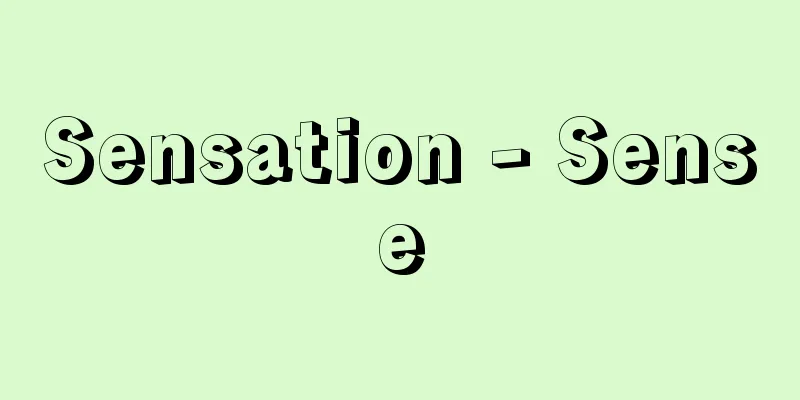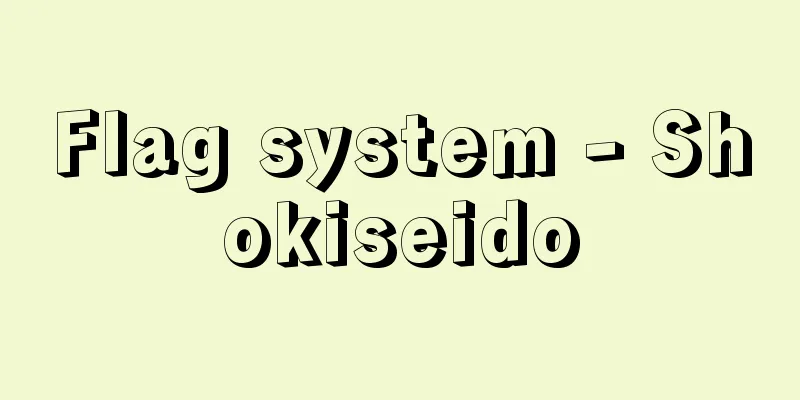Sensation - Sense

|
Sensation is a conscious process that is directly caused by external events such as light or sound, or by internal events such as distortion of biological tissues or chemical substances in the body. In contrast, when a representation of a stimulus source or object is constructed using sensation as material and further adding higher-level neural functions such as memory and inference, this is called perception, and knowing what a stimulus source or object is from several types of perception is called cognition. For example, when electromagnetic waves of a certain wavelength stimulate the eyes and a simple consciousness of "blue" arises, this is called sensation, and when it is specifically judged that this is the blue of the leaves and not the blue of the sea, this is called perception. Furthermore, when several sensory stimuli are added at the same time and one recognizes that it is the blue of the garden tree in front of one's eyes, this is called cognition. Thus, perception and cognition are considered to be higher-level mental phenomena that occur through the senses, but in reality, it is difficult to make a clear distinction between the three, especially between sensation and perception. [Masamichi Ichioka] Structure of the sensory systemSensations arise through three processes: (1) Sensory receptor: A receptor that receives sensory stimuli and converts physical or chemical energy stimuli into a series of action potentials in the sensory nerve, that is, a sensory signal. In other words, a receptor can be considered a kind of energy converter. (2) Sensory nerves Analog (quantitative) sensory stimuli applied to receptors are digitized (quantified) by the receptors and converted into nerve impulses. These sensory signals are transmitted centripetally through the sensory nervous system, undergoing various modifications. (3) The sensory cortex is where sensory nerve impulses are converted into sensations, but the mechanism of this conversion is not yet clear. [Masamichi Ichioka] Classification of sensationsOne way of classifying the senses from a morphological point of view is as follows: [I] Special senses: vision, hearing, taste, smell, balance [II] Somatic senses Among the somatic sensations, touch, pressure, and vibration are all stimuli caused by the deformation or distortion of the skin or subcutaneous tissue, i.e., the movement of tissue. These sensations are of the same dimension, differing only in the speed of adaptation (described below), and are therefore collectively referred to as kinesthesia. The receptors for this sensation are Meissner tactile corpuscle-like nerve endings in the skin and Vater-Pacini corpuscles (encrusted nerve endings) subcutaneously. Deep sensation is the sensation that arises from the muscles, tendons, periosteum, etc., located between the skin and the internal organs. Of these, kinesthesia is a sensation that arises from afferent information from tension receptors in muscle spindles and tendon spindles, and it senses the relative positions of the limbs, the movement of the limbs, and the weight and resistance of objects. [Masamichi Ichioka] The qualities of sensationSome common properties of sensations are: (1) Law of special sensory energy Pressing the eyeball or electrically stimulating the optic nerve produces the same sensation of light as when light acts on the eye. In this way, no matter what kind of stimulus is applied to any part of the sensory system from the receptors to the sensory areas of the cerebral cortex, a specific sensation specific to that sensory system is produced. This is called the "Law of Special Sensory Energy," and was proposed by the German physiologist JP Müller. Müller believed that "each sensory system carries out its own unique activity." (2) Appropriate Stimulus Receptors are excited by various types of stimuli, but there are certain types of stimuli to which they react most sensitively, called appropriate stimuli. An example is the light stimulus applied to photoreceptor cells. (3) Sensory projection Sensory stimuli applied to the body excite the sensory cortex, generating a sensation, but the sensation is not felt as something that occurs inside the brain, but as something caused by an object in the outside world, or as something that occurs in the part of the body to which the stimulus was applied. This is sensory projection, and the process of identifying the part to which the stimulus was applied through projection is called localization. For example, if an object touches the back of the second finger on the left hand, the sense of touch is generated in the somatosensory cortex, but in reality, the sensation is felt as if the object has touched that part of the body. (4) Intensity and duration of stimulus If the stimulus is too weak, no sensation is produced, but if a weak stimulus is given repeatedly, eventually a sensation may be produced (latent accumulation). Furthermore, when a stimulus is given, the sensation does not occur immediately, but gradually (gradual increase), and when the stimulus is stopped, the sensation does not disappear immediately, but gradually disappears (gradual decrease). Furthermore, when the same stimulus is given continuously, the sensation gradually becomes dull (adaptation). There are some senses that adapt quickly, such as touch and smell, and others that adapt slowly, such as pain and deep sensation. Sensations that adapt slowly are felt with roughly the same intensity while the stimulus is being applied. We stop being conscious of wearing glasses or a hat over time, but the pain caused by a pebble in our shoes continues forever. This is because the former is caused by touch, which adapts quickly, and the latter is caused by pain, which adapts slowly. (5) Weber-Fechner Law When two stimuli are presented simultaneously or sequentially, the smallest difference between them that can be recognized is called the "discrimination threshold." E. H. Weber of Germany found that if the strength of one stimulus is R and the discrimination threshold is ΔR , then ΔR / R is almost constant if R is of moderate strength. This is called "Weber's Law," and ΔR / R = C is called the Weber ratio ( C is a constant). For example, if 100 grams can be distinguished from 110 grams, and 500 grams from 550 grams, then ΔR / R is 10% for both, and is constant. Later, Fechner of Germany started from this law and theoretically determined that the magnitude of sensation E is proportional to the logarithm of the strength of the stimulus R ( E = k 1 log R ) (k 1 is a constant). This is called the Weber-Fechner Law. This psychophysical law has long been criticized for its flawed starting point, but in recent years, American psychologist S.S. Stevens has experimentally demonstrated that there is a relationship between the magnitude of sensation E and the strength of a stimulus R : E = k2Rn ( k2 and n are constants). This is called the " power function law." (6) Contrast of sensations The nature and magnitude of sensations change depending on the stimuli given simultaneously or sequentially. This is called contrast. For example, the same gray paper appears white on a black background and black on a white background. This is called simultaneous contrast. When you taste a certain flavor and then take a sip of distilled water, it tastes different. This is called successive contrast. [Masamichi Ichioka] Animal SensesIn order for animals to respond to environmental changes (stimuli) inside and outside the body and maintain their vital functions in the most favorable state, they must constantly detect stimuli inside and outside the body. The function of detecting environmental changes inside and outside the body as stimuli is called sense, and the organs involved in this function are called sensory organs. Animals first receive environmental changes, that is, various stimuli, such as physical or chemical energy, in parts of their bodies, and then respond appropriately to them. Therefore, in addition to being classified by the type of receptor, animals' senses are also classified by the type of energy, or appropriate stimuli. When the stimuli are chemical substances, they are called chemical senses, and include taste and smell. The place where the stimuli are received is called a chemoreceptor. On the other hand, those that are caused by physical stimuli are called physical senses, which are further classified into mechanoreception (sound reception, vibration reception, equilibrium reception, proprioception), thermoreception, light reception, etc. In order to receive these various stimuli most effectively and transmit them as information to the central nervous system, developed receptors are required. Before the stimuli received by these receptors are recognized as sensations in the brain, several stages of neural processes must be passed. The process by which sensations are processed in the brain as neural information and then expressed as adaptive behavior is called sensory information processing. The following describes the sensations currently understood as sensory information from the perspective of physiology and behavioral biology. [Kiyoshi Aoki] Sensation as sensory information(1) There are four basic types of taste sensations: sour, sweet, bitter, and salty, but there are no receptors that respond specifically to these four basic tastes. However, it is known that humans are the most sensitive to sweetness among animals. In addition, although the brain can recognize tastes, the mechanism behind the complex and subtle taste sensations that humans feel is not known. (2) Among the senses of sound, meaningful information includes the recognition of human vocalizations and communication between animals of the same species, which are generated by information being sent to the auditory cortex via the auditory afferent pathway. (3) The sense of smell is generated when odorants are received by the odor receptor cells in the nasal mucosa and then transmitted to the olfactory cortex in the frontal lobe of the brain. However, it is still unknown which elements of the smell are transmitted and how. (4) Visual information is transmitted through a complex network of cells in the retina, including photoreceptors, bipolar cells, horizontal cells, and amacrine cells, and then passes through optic ganglion cells to the lateral geniculate body after the optic nerve crosses. However, in animals that do not have binocular vision, the optic tectum in the midbrain is the highest center for visual sensation. In mammals and above, areas 17, 18, and 19 of the visual cortex of the cerebral cortex are the highest centers for vision. (5) Skin sensations such as touch, temperature, and pain are transmitted via the posterior column nuclei to the ventral basal ganglia of the thalamus and then to the somatosensory cortex of the cerebral cortex. This sensory cortex is the highest center. [Kiyoshi Aoki] Mechanism of sensory information processingI have described where each type of sensation originates, but the mechanism of the highest sensory center has been well studied in the study of vision by American physiologists Hubel and T.N. Wiesel. In their research on the neuronal level of the cerebral cortex, they discovered that visual neurons have two different neuronal layers that detect specific positions in the field of vision. These two are simple detection neurons, and a higher level of neurons, the latter of which is a complex detection neuron that responds to black lines in the same direction regardless of their position. By studying these two types of neurons, they demonstrated the existence of a hierarchy of sensations, and further demonstrated a hierarchical model of the center where sensations are perceived and expressed as behavior, using vision as an example. The hierarchical model of this sensory information processing mechanism is shown in . In this diagram, S indicates the sensory system, and M indicates the motor system. S41 indicates the sensory receptor cell layer for vision, hearing, smell, taste, etc. Taking vision as an example, the visual cortex of the cerebral cortex from the retina is shown to ascend to higher centers, S41 , S31 , S21 , S11 , and S01 . S22 and S23 indicate neurons that act as controls for a series of sensory information systems. S01 is a neuron that, for example, triggers the sensation that a fly has started to move when a frog has a fly in its field of vision. Activation of this S01 activates M01 , the highest center for feeding, which in turn stimulates M11 , causing the frog to turn and aim in the direction of the fly. This is called orientation, and means that the animal has sensed and perceived it. [Kiyoshi Aoki] Species-specific sensory recognition neuronsTraditionally, there has been a theory of the environmental world, which states that if the precision of an animal's sensory organs differs, then the world for each animal is different, and that the environment is subjective. As a result of the research of both groups, it has been discovered that even if animals have almost the same sensory organs, the environmental world is different because the neurons that detect stimuli in the subsequent information processing are different. Therefore, it can be said that much of the species-specificity of sensations seen as instinctive behavior in animals originates from the existence and function of species-specific detection neurons in the sensory system. Examples of such sensations include the following. First, the dance of honeybees is an expression of "interpreting the vertical direction as the direction of the sun." In other words, it is thought that there is a neuron in the center that reads both visual stimuli and mechanical stimuli from the sensory hairs on the surface of the body, and that this is the result of a single neuron detecting the direction of light and the direction of gravity. Also, owls can hear sounds thanks to the function of neurons that have the ability to detect the direction of the sound source with high accuracy. However, in other areas of the cerebral cortex, there are neurons that respond to both vision and hearing, and in this case, a single neuron responds to both light and sound coming from the same direction. These examples show the existence of sensory recognition neurons that receive information from two or more different sensory systems. [Kiyoshi Aoki] Senses in plantsPlants generally do not have special organs that undergo the animal physiological processes of receiving, transmitting, and recognizing stimuli (in particular they lack organs for recognition), so they do not have senses in the strict sense. However, plants have parts that receive stimuli, and the sensed stimuli are transmitted and a reaction is seen in a specific part. Therefore, the senses of plants can be treated as synonymous with the reception of stimuli from the outside world. Below, we will discuss the senses of plants from this perspective. [Masayuki Katsumi] Gravitational stimulationPlants change their posture in response to gravity. A typical example is geotropism. The receptor site for such gravitational stimuli is the tip of the root or stem. In roots, the receptor site is generally several millimeters from the tip, and in the case of the coleoptile of macaroni, the receptor site is approximately 10 millimeters from the tip. Sensitivity to gravitational stimuli varies depending on the type, part, developmental stage, and external conditions of the plant. The minimum time required for a reaction (threshold time) is usually around 20 minutes for roots and 5 to 10 minutes for stems. Mature leaves of fern are particularly fast, at 30 seconds. The mechanism of receptors for gravitational stimuli is not yet clear, but there is an explanation based on the statolith hypothesis (also called the statolith theory). Within the cells of the receptor site for gravitational stimuli, there are mobile, heavy amyloplasts (starch granules) called statoliths. When the position of the cell changes, the amyloplasts move in the direction of gravity and gather at the lowest point in the cell. The idea is that gravity is sensed by contact stimulation with the cell membrane at that location. At present, there is both evidence that supports and refutes this theory, so it is difficult to decide which is the case. [Masayuki Katsumi] Light stimulationPlants react to light in a way known as phototropism and phototropism. In the case of phototropism in coleoptiles and stems, the light-sensitive part is the tip. In the case of oat coleoptiles, the tip 50 micrometers is the most sensitive. In the case of phototropism and heliotropy, the leaves are the light-sensitive part. The intensity of light required to cause phototropism varies depending on the plant and the observation conditions, but the light stimulus that causes a certain amount of bending is determined by the amount of light, not the luminous intensity. Light stimuli are sensed by photoreceptor substances. In the case of the coleoptile of oatmeal, blue light is most effective, and based on the action spectrum, it is thought that carotene or flavin-type substances may be involved. The flat chloroplasts contained in the cells of a type of green algae, Hydaria, move so that their faces are parallel to the light. In this case, the photoreceptor substance is phytochrome. Phytochrome is also involved in the phototropic movement of plants such as Mimosa pudica and Misty the Habensis. [Masayuki Katsumi] Mechanical stimulationSome plants react to stimuli such as contact, vibration, and wind pressure through tactile tropism, tactile tilt, and seismicity. The trapping leaves of carnivorous plants have special organs that receive contact stimuli. The inside of the trapping leaves of Venus flytrap and Venus flytrap have sensory hairs that bend at the base when stimulated, causing special cells in that area to deform. The receptors that receive stimuli in tactile tropism have not yet been clarified. The changes in the sensory hairs and the seismic movement of Mimosa pudica transmit action potentials very quickly after receiving the stimulus, so it is thought that the receptors are related to the generation of action potentials. [Masayuki Katsumi] Other stimuliFlowers such as tulips, saffron, and crocuses respond sensitively to temperature changes by opening and closing. Saffron flowers begin to open with a temperature rise of 0.2°C. Pollen tubes and mold hyphae respond to chemical stimuli and exhibit tropism, and the trapping leaves of carnivorous plants exhibit tropism. [Masayuki Katsumi] "New Physiology, Vol. 1, edited by Tonoda Naoki et al., 5th edition (1982, Igaku-Shoin) " "Perspectives on Medical Physiology, written by W.F. Ganong, translated by Okada Yasunobu et al., 20th edition (2002, Maruzen)" [References] | | | | | | | | |©Shogakukan "> Hierarchical model of sensory information processing mechanism (Figure) Source: Shogakukan Encyclopedia Nipponica About Encyclopedia Nipponica Information | Legend |
|
光や音のような生体外の事象とか、生体組織のゆがみや体内の化学物質といった生体内の事象によって直接おこされた意識過程を感覚という。これに対し、感覚を素材として、さらに記憶とか推理とかの高次の神経作用を加えて、刺激源、あるいは対象物に関する表象が構成されるとき、これを知覚perceptionといい、幾種類かの知覚から刺激源や対象物がなんであるかを知ることを認知cognitionという。たとえば、ある波長の電磁波が目を刺激し「青い」という単純な意識が生じたとき、これを感覚といい、これが木の葉の青さであって海の青さでないと具体的に判断されるとき、これを知覚という。さらに、同時に加えられたいくつかの感覚刺激によって、それは眼前の庭木の青さであると認めるとき、これを認知という。このように、いちおう知覚と認知とは、感覚を介して生ずる一段高次の精神現象とされているが、実際には、三者の間、とくに感覚と知覚との間に判然とした区別をつけることはむずかしい。 [市岡正道] 感覚系の構成感覚は次の三つの働きによって生ずる。 (1)感覚受容器 感覚刺激を受け入れる受容器で、物理的あるいは化学的エネルギーの刺激を感覚神経の一連の活動電位、すなわち感覚信号に変換する器官である。つまり、受容器は一種のエネルギー変換器といえる。 (2)感覚神経 受容器に加えられたアナログ性(計量性)の感覚刺激は、受容器でデジタル化(計数化)され、神経インパルスに変換される。この感覚信号は、感覚神経系中をさまざまな修飾を受けながら求心性に伝達される。 (3)大脳皮質感覚領 感覚神経インパルスが感覚に変換されるところである。しかし、その変換のメカニズムは、現在のところ解明されていない。 [市岡正道] 感覚の分類形態学的な見地からの一つの分類法として、感覚は次のように分けられる。 〔Ⅰ〕特殊感覚……視覚、聴覚、味覚、嗅覚(きゅうかく)、平衡感覚 体性感覚のなかの触覚、圧覚、振動感覚は、いずれも皮膚や皮下組織の変形、あるいはゆがみといった、いわば組織の動きが刺激となっておこるものである。これらの感覚は、単に順応(後述)の遅速が違うだけにすぎない同一次元の感覚であるため、一括して動き受容感覚とされる。この感覚の受容器は、皮膚ではマイスネルMeissner触覚小体様の神経終末であり、皮下ではファテル‐パチニVater-Pacini小体(被覆性神経終末)である。 深部感覚とは、皮膚と内臓との中間にある筋、腱(けん)、骨膜などからおこる感覚をいう。このうち運動感覚は、筋紡錘や腱紡錘中の張力受容器からの求心性情報によっておこる感覚で、四肢の相対的位置関係、四肢の運動、物体の重量や抵抗を感ずるものである。 [市岡正道] 感覚の諸性質感覚がもつ一般的な性質には次のようなものがある。 (1)特殊感覚エネルギーの法則 眼球を圧迫しても、視神経を電気刺激しても、目に光が作用したときと同じように光の感覚がおこる。このように、受容器から大脳皮質感覚領までの感覚系統において、そのどの部分に、どのような種類の刺激を作用させても、その感覚系統に固有な特定の感覚が生ずる。これを「特殊感覚エネルギーの法則」といい、ドイツの生理学者ミュラーJ. P. Müllerによって提唱された。ミュラーは、「各感覚系統はそれぞれ固有の活動を営む」と考えたのであった。 (2)適当刺激 受容器は各種の刺激で興奮するが、もっとも敏感に反応する特別な種類の刺激があり、これを適当刺激という。視細胞に対する光刺激などがその一例である。 (3)感覚の投射 身体に加えられた感覚刺激は、大脳皮質感覚領に興奮をおこし、感覚が生ずるわけであるが、その感覚は脳内のできごととして感じられるのではなく、外界の対象物によって生じたもの、あるいは刺激の加えられた身体部位に生じたものとして感じられる。これが感覚の投射であり、投射によって刺激の加わった部位を知ることを定位という。たとえば、左手第2指指背に物が触れたとすると、触覚は大脳皮質体性感覚領に生ずるが、実際には身体当該部位に物が触れたと感ずるなどである。 (4)刺激の強弱と時間 刺激が弱すぎれば感覚はおこらないが、弱い刺激でも反復して与えられると、ついには感覚が生ずることがある(潜伏加重)。また、感覚は刺激を与えても、すぐに生ずるものではなく、徐々におこってくるものであり(漸増)、刺激をやめても即時に感覚がなくなるものではなく、やはり、徐々に消えてゆくものである(漸減)。さらに、同一の刺激が持続的に与えられていると、感覚はしだいに鈍くなっていく(順応)。感覚のうちには、触覚、嗅覚のように順応の速いものと、痛覚や深部感覚のように順応の遅いものとがある。順応の遅い感覚は、刺激が加わっている間はほぼ同じ強さで感じられる。眼鏡や帽子の着用は時間の経過とともに意識しなくなるが、靴の中の小石による痛みはいつまでも続く。これは前者が順応の速い触覚によるものであり、後者が順応の遅い痛覚によるためである。 (5)ウェーバー‐フェヒナーの法則 二つの刺激を同時に、あるいは順次に与えたとき、認知できる両者の最小差を「弁別閾(べんべついき)」という。ドイツのE・H・ウェーバーは、一方の刺激の強さをR、弁別閾をΔRとすると、ΔR/Rは、Rが中等度の強さであれば、ほぼ一定であることをみいだした。これを「ウェーバーの法則」といい、ΔR/R=Cをウェーバー比(Cは定数)という。たとえば、100グラムと110グラムとが、また500グラムと550グラムとが弁別できたとすると、ΔR/Rは両者において10%となり、一定であるということになる。その後、ドイツのフェヒナーは、この法則から出発して、感覚の大きさEは刺激の強さRの対数に比例する(E=k1logR)ことを理論的に求めた(k1は定数)。これをウェーバー‐フェヒナーの法則という。この精神物理的な法則は、以前から、考え方の出発点において難点があると批判されてきたが、近年アメリカの心理学者S・S・スティーブンスは、感覚の大きさEと刺激の強さRとの間には、E=k2Rnの関係があることを実験的に求めた(k2, nは定数)。これを「べき関数の法則」という。 (6)感覚の対比 感覚は、同時に、あるいは順次に与えられた刺激によって、その性質や大きさが変わる。これを対比という。たとえば、同じ灰色の紙が、黒地の上では白く、白地の上では黒く見えるなどは同時的対比とよび、ある味を味わったあとに蒸留水を口にすると、別の味を呈するなどは継時的対比とよぶ。 [市岡正道] 動物の感覚動物が体の内外の環境変化(刺激)に対応しながら、自己の生活機能をもっとも有利な状態に維持していくためには、絶えず体の内外の刺激を検出していなければならない。このように体の内外の環境の変化を刺激として感知する機能を感覚といい、これにあずかる器官を感覚器とよぶ。動物は環境の変化、すなわち種々の刺激である物理的または化学的エネルギーをまずは体の一部で受容し、それに対して適切な反応をする。したがって動物の感覚は、受容器の種類による分類以外に、これらのエネルギーすなわち適当刺激の種類によっても分類される。刺激が化学物質である場合は化学感覚といわれ、味覚と嗅覚とがある。また、その刺激を受容する場所を化学受容器という。一方、物理刺激によるものは物理感覚とよばれ、それはさらに機械受容(音受容、振動受容、平衡受容、自己受容)、温度受容、光受容などに分類される。そして、これら各種の刺激をもっとも効果的に受容し、情報として中枢に伝えるためには、発達した受容器が必要となる。この受容器によって受容された刺激が感覚として脳で意識されるまでには、何段階かの神経過程を経なければならない。感覚が神経情報として脳内で処理され、さらに適応行動として発現するまでの過程を、感覚情報処理という。現在の生理学と行動生物学の面から、感覚情報として理解されている感覚について次に述べる。 [青木 清] 感覚情報としての感覚(1)味の感覚には酸・甘・苦・塩の四基本型があるが、これら四つの基本の味に特異的に応じる受容器はない。しかし、動物のなかでヒトが甘味にいちばん敏感なことなどが知られている。また、脳では味を認識できるが、ヒトが感じる味の複雑微妙な感覚のメカニズムについてはわかっていない。 (2)音の感覚のうちで、意味をもつ情報としては、ヒトの声によることばの認識と同種間動物のコミュニケーションとがある。これらは、聴覚求心経路を経て聴覚領野に情報が送られることによって生ずる。 (3)においの感覚は、鼻腔(びくう)粘膜のにおい受容細胞で受け取られたのち、大脳の前頭葉嗅領野まで送られて生ずる。しかし、においのどの要素がどのように送られるかは、まだわかっていない。 (4)視覚情報による感覚は、視細胞、双極細胞、水平細胞、アマクリン細胞などといった網膜内で複雑に絡み合った細胞群で連絡されたのち、視神経節細胞を経て視神経交差後に外側膝状体(しつじょうたい)に行く。しかし両眼視を行わない動物では、中脳視蓋(しがい)が視覚感覚の最高位中枢となっている。哺乳(ほにゅう)類以上では、大脳皮質の視覚領の17、18、19野が視覚の最高位中枢となっている。 (5)触覚、温度覚、痛覚などの皮膚感覚は、後索核を経て視床腹側基底核群に入り、大脳皮質体性感覚野に情報として伝わる。この感覚野が最高中枢である。 [青木 清] 感覚情報処理の機構各種感覚がどこで生ずるかを述べてきたが、感覚における最高中枢の機構がよく調べられているのは、アメリカの生理学者ヒューベルとT・N・ウィーゼルが研究した視覚に関してである。彼らは大脳皮質のニューロンレベルの研究のなかで、視覚ニューロンには、視界の特定の位置を検出する二つの異なるニューロン層があることを発見した。その二つとは、単純型検出ニューロン、およびさらに上位のニューロンで、後者は、どの位置にあっても同方向の黒線であれば反応する複雑型検出ニューロンである。この2種のニューロンの研究により彼らは、感覚としての階層性の存在を示し、さらに視覚を例として感覚が知覚され行動として発現する中枢の階層性モデルを示すことができた。この感覚情報処理機構を階層性モデルで示すとのようになる。 この図に示されるSは感覚系をさしており、Mは運動系をさしている。S41は視覚、聴覚、嗅覚、味覚などの感覚受容細胞層を示す。視覚を例にすると、網膜から大脳皮質の視覚領野がS41、S31、S21、S11、S01としだいに上位の中枢へとあがることを示している。S22、S23は一連の感覚情報系への制御として働くニューロンを示す。またS01は、たとえばカエルがハエを視界中に収めていて、ハエが動きだしたという感覚をおこすニューロンである。このS01の活性化が摂食のための最高中枢M01を活性化し、さらにそのM01がM11を刺激してカエルはハエの方向に向き照準を定めることになる。これを定位するといって、動物が感覚し知覚したことを意味する。 [青木 清] 種特異的な感覚認識ニューロン従来から、動物の感覚器の精度が異なれば、それに伴いそれぞれの動物にとっての世界は異なり、環境とは主体的なものであるという環境世界説があった。両者の研究の結果、さらに、ほとんど同じ感覚器をもっていても、その後の情報処理において刺激を検出するニューロンが異なることで、環境世界が異なるということがわかったわけである。したがって、動物において本能行動としてみられる感覚としての種特異性の多くは、感覚系の種特異的検出ニューロンの存在、およびその働きに由来するといえる。 このような感覚の例には次のようなものがある。まずミツバチのダンスであるが、これは「垂直方向を太陽方向に読み替える」ことの表現である。すなわち、視覚刺激と体表の感覚毛の機械的刺激との両方を読むニューロンが中枢にあって、明るい方向と重力の方向を一つのニューロンが検出している結果であると考えられる。またフクロウが音を聞くのは、音源の方向を高い精度で検出する能力をもつニューロンの働きによる。しかしそれとは別に、大脳皮質のほかの領野には視覚と聴覚とに応答するニューロンが存在していて、ここでは一つのニューロンが同じ方向からくる光と音との両方に応答することになる。これらの例から、二つ以上の異種感覚系からの情報を受け取る感覚認識ニューロンの存在が知られる。 [青木 清] 植物における感覚植物は一般に刺激の受容・伝達・認識という、動物生理学的な過程を経る特別の器官をもたない(とくに認識のための器官を欠く)ので、厳密な意味での感覚はない。しかし、植物には刺激を受容する部分があり、感受された刺激は伝達され、特定の部分で反応がみられる。したがって、植物における感覚とは、外界の刺激の受容と同義に扱ってよいであろう。以下、こうした意味からの植物の感覚について述べる。 [勝見允行] 重力刺激植物は重力に反応して姿勢を変える。その代表的な例が屈地性である。こうした重力刺激の受容部位は根や茎の場合、その先端である。根では一般に先端数ミリメートルのところまで、マカラスムギの子葉鞘(しようしょう)では先端約10ミリメートルのところまでが感受部位である。重力刺激に対する感度は、植物の種類、部分、発育段階、外界の諸条件によって異なる。反応を得るために必要な最少刺激時間(刺激閾時)は、根では20分前後、茎では5~10分が普通である。ゼンマイの成熟葉はとくに速く30秒である。重力刺激の受容機構はまだ明らかではないが、スタトリスstatolith説(平衡石(へいこうせき)説ともいう)による説明がある。重力刺激感受部位の細胞内にはスタトリスとよばれる、動きやすく、重いアミロプラスト(デンプン粒)があり、細胞の位置が変わると、アミロプラストは重力方向に動き、細胞内のいちばん低い場所に集まる。その場所での細胞膜との接触刺激で重力を感知するという考えである。現在のところ、この説を支持する事実、否定する事実の両方があって、いずれかは決めがたい。 [勝見允行] 光刺激植物は、屈光性、傾光性というように、光に対して反応を示す。子葉鞘や茎の屈光現象の場合、光を感受する部位は先端部である。マカラスムギの子葉鞘では先端50マイクロメートルがもっとも鋭敏である。傾光性や横日(おうじつ)性の場合には葉が光感受部位となる。 屈光現象をおこすのに必要な光の強さは、植物によっても、観察条件によっても異なるが、一定の大きさの屈曲をおこす光の刺激は、光度ではなく光量によって決められる。 光刺激は光受容物質によって感受される。マカラスムギの子葉鞘の場合、青色光がもっとも有効であり、作用スペクトルから、カロチンまたはフラビン系統の物質が関与するのではないかと考えられている。ヒザリオ(緑藻類)の一種の細胞に含まれる平らな葉緑体では、その面が光と平行になるように移動する。この場合、光受容物質はフィトクロムである。また、オジギソウやネムノキなどの傾光性運動でもフィトクロムが関係している。 [勝見允行] 機械的刺激ある種の植物は屈触性、傾触性、傾震性のように接触、あるいは震動、風圧などの刺激に反応する。食虫植物の捕虫葉には接触刺激を受容する特別な器官がある。ムジナモやハエジゴクの捕虫葉の内側には感覚毛があって、刺激を与えると基部で折れ曲がり、その部分にある特別な細胞が変形する。傾性における刺激の受容体については、まだ明らかにされていない。感覚毛の変化や、オジギソウの傾震運動は、刺激受容後にきわめて短時間で活動電位が伝わるので、受容体は活動電位の発生に関係したものとも考えられる。 [勝見允行] その他の刺激チューリップ、サフラン、クロッカスなどの花は温度差に敏感に反応して開閉運動を行う。サフランの花は0.2℃の温度上昇で開き始める。 花粉管やカビの菌糸は化学的刺激に反応し屈化性を示すし、食虫植物の捕虫葉は傾化性を示す。 [勝見允行] 『問田直幹他編『新生理学 上巻』第5版(1982・医学書院)』▽『W・F・ギャノング著、岡田泰伸他訳『医科生理学展望』原書20版(2002・丸善)』 [参照項目] | | | | | | | | |©Shogakukan"> 感覚情報処理機構の階層性モデル〔図〕 出典 小学館 日本大百科全書(ニッポニカ)日本大百科全書(ニッポニカ)について 情報 | 凡例 |
<<: Chinese classics - Kangaku
Recommend
Meiwa Gikan - Meiwa Gikan
Kabuki information. Written by Omi Sanmaro, real n...
Kush
...Kings and queens were buried near Napata, and ...
Palanquin - Koshi
There are two types of palanquin: agekoshi (shoul...
Yuge Temple
An ancient temple located in Yao City, Osaka Prefe...
Amulet - weight
〘 noun 〙 ("o" is a prefix) 1. The act of...
Meganeura - Meganeura
Meganeura is also read as Meganeura. It is a foss...
Ulyanov, VI
…Leader of the Russian Revolution and founder of ...
The School of Politics - Jikougakuha (English spelling)
A school of thought that arose in Zhejiang Provinc...
Astley Royal Theatre - Astley Royal Theatre
The modern circus was founded in 1770 by Philip A...
Minnesinger
…A general term for medieval German knight-poets....
Lecane luna (English spelling) Lecaneluna
...Their diet includes phytoplankton, water fleas...
Axial piston pump - Axial piston pump
…Special steel is often used as the material for ...
throw forward
…smother tackleA tackle in which the opponent is ...
Report of the Committee on the Functioning of the Financial System
…The official name of this committee was the Comm...
Himeji [city] - Himeji
A city in the southwest of Hyogo Prefecture. It wa...









